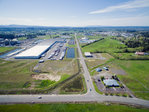

The Port of Chehalis just finished its best year in history, with an unprecedented number of property sales in a single year and a full slate of leased properties.
Maneuvering through many challenges, the port is currently celebrating its 30th anniversary, and things only seem to be getting better.
Randy Mueller, chief executive officer of the port, said the progress has shown a good amount of demand in the local area.
“The Great Recession theoretically ended in 2010, but like everything else, things take a little while longer to trickle down to Lewis County,” he said. “We started seeing a real increase in activity in 2014 and 2015.”
The port weathered the economic hard times, and continued to move forward with the preparation of sites for future development, he said.
The port’s leasable properties that once sat vacant began to fill up.
“Now they’re all leased up,” Mueller said. “I have nothing to lease anyone right now. We have full occupancy, which is both good and bad. It shows demand and that folks are coming in, but at the same time I would like to have more facilities to lease out to people.”
Along with no leasable vacancies, the port closed three sales, the most it has ever completed in any given year. The previous record for sold properties was in 2015, when two sales were completed.
“We’re breaking sales and have recorded breaking leases so things are definitely on the upward trajectory,” Mueller said.
After a countywide effort to create a port failed, three communities looked to create their own ports. Chehalis and Centralia were successful, while Winlock did not secure enough yes votes to do so.
The ports in the Twin Cities were created, and began collecting taxes in 1988.
The Port of Chehalis came into existence in part due to less than 75 votes. In September 1986, voters of the Chehalis School District approved the port, with a close 1,426 in favor and 1,352 voters who opposed the measure.
Shortly after, the first port commissioners were sworn into office, with Bill Brooks, Ed Pemerl and Bill Wiester taking the seats on the board.
“I was of course thrilled to death to be elected and be part of the decision-making right at the first part,” Brooks, now 85, told The Chronicle.
According to Brooks, who now resides in Idaho, the greatest benefit of the port is the industries that it has generated in the area.
“We didn’t own a dime’s worth of anything,” Brooks said. “They came from ground zero to be a pretty influential builder of industry around Chehalis.”
The first chairman of the port said there were many challenges after the port’s creation, all of which were navigated through.
“We had to find some money, and I guess one of the first acts we had to do is go borrow some money so we could make a payroll, so to speak,” Brooks said.
Commissioner Mark Giffey, the longest-serving port commissioner with 24 years of experience, said the first six years of the port district were focused on building up enough cash to purchase property, and then later start development work.
Port Attorney Brian Kelly also said the focus in the beginning was on the formation and trying to establish a plan of development. Kelly has been with the port since the beginning.
“The decisions that are made by the commissioners are community-based,” Kelly said. “They make their decisions on how it helps the constituents and not necessarily what they would personally like to see, but they put their interests second to the community.”
Later in 1992, the port hired its first employee, Heidi Pehl, as executive director. Kelly said she “did a wonderful job in fostering and the growth of the port.”
Typically, investors will come in to build the roads, as well as the water and sewer lines needed for businesses, but given the location of Chehalis, Giffey said, that responsibility was originally left up to the port.
“We were too far away from (Seattle and Portland) at that time for outside money to really show much interest in investing here in Lewis County, and so that’s why the port districts basically formed, so we could actually develop capital to build infrastructure to build jobs,” he said. “We pretty much had to levy the maximum amount so we could pay off the loans that went with the initial debts to build the water, roads and sewers.”
Once some of the primary infrastructure was in place, the port sold its first property to Fred Meyer, which remains in the industrial area and has since expanded its building.
After that, more land sales were completed.
The port currently has over 200 acres for sale, ranging in size anywhere from 1 acre to 110 acres, Mueller said.
“We have something from small to medium to large that will fit everyone’s needs,” Mueller said.
The main goal of the port, in Giffey’s opinion, is to create more opportunities for employment for Lewis County residents, in part to allow people’s kids the opportunity to stay in the county once they graduate from high school.
That comes as part of a “balancing act,” Giffey said, taking into account the number of jobs per acre a business offers, and bringing in industry that will enhance the area’s tax base.
“My goal would be to try to get somebody to come to town that does require a higher skill level, which would then equate to a higher wage scale for those people in the Chehalis and Lewis County communities,” Giffey said.
Currently the port has helped develop anywhere from 2,200 to 2,500 jobs.
As the port continues to grow, those involved said they would like to see more focus on technology-based jobs, those involving STEM — science, technology, engineering, and mathematics — as well as manufacturing jobs, which bring in fairly substantial wages.
An important part of the port’s mission is the partnerships it has created along the way, including one with the Chehalis Industrial Commission, which helped bring the port to fruition. Formed in 1956, the Industrial Commission had the goal of increasing business and employment opportunities in the area.
Mueller said the port continues to work closely with the Industrial Commission, especially since both entities have a similar mission.
Buck Hubbert, with the Industrial Commission, said the entity strongly encouraged the port’s formation, especially because it would be able to raise funds and have a tax base, which the commission could not.
“That allowed the port to do some infrastructure work that was important to the future,” he said. “They have a good judgment of what kind of business to bring into the port and that’s important.”
The port will continue to grow and serve the citizens of Chehalis, officials said.
Right now, the port is in the process of working on other potential sales, and Mueller said hopefully there will be some announcements in the future once details are solidified.
“We are working on acquiring more properties to lease out at the same time,” he said. “We’ve been able to pay down debt, and we take that money from developing properties and reinvest it in other properties to keep that cycle going.”
Kelly, the port’s attorney, said the port will continue to look for quality jobs and quality employers, something commissioner Giffey agreed with.
“I appreciate Chehalis residents’ willingness to take money out of their wallet to possibly give them an opportunity for them or their families to have a better life or better employment opportunity,” he said. “The commissioners are happy and proud of what we’ve been able to accomplish, and I hope Chehalis taxpayers are happy and proud of what we were able to accomplish.”